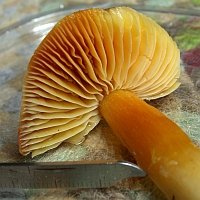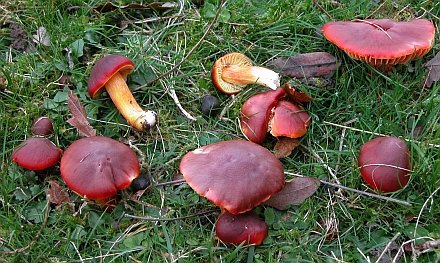Hygrocybe punicea (Fr.) P. Kumm., the crimson waxcap.
Classification
Kingdom Fungi
Phylum Basidiomycota
Class Basidiomycetes
Order Agaricales
Family Tricholomataceae
Genus Hygrocybe
Synonyms
Agaricus puniceus Fr.
Syst. mycol. (Lundae) 1: 104 (1821)
Godfrinia acutopunicea (R. Haller Aar. & F.H. Møller) Herink
Sborník severočeského Musea, Historia Naturalis 1: 65 (1958)
Godfrinia punicea (Fr.) Herink
Sborník severočeského Musea, Historia Naturalis 1: 68 (1958)
Hygrocybe acutopunicea R. Haller Aar. & F.H. Møller
Schweiz. Z. Pilzk. 34: 66 (1956)
Hygrophorus puniceus (Fr.) Fr.
Epicr. syst. mycol. (Upsaliae): 331 (1838)
Pseudohygrocybe punicea (Fr.) Kovalenko
Mikol. Fitopatol. 22(3): 208 (1988)
Common names
Scarlet- or crimson-waxy cap
Granaatbloemwasplaat (Dutch)
Scharlakansvaxing (Swedish)
Description
Cap: 4-10 cm diameter, initially campanulate, and later flattening, often with involute margin, blood- to dark red in colour; context up to 5 mm thick, brittle, yellow.
Gills: thick and widely spaced, adnate or emarginate with decurrent tooth, yellow-red in colour.

Spore print: white.
Spores: broadly elliptical, 7–10.5 x 4.5–5.5 µm.
Stem: 5-12 cm high, 0.9-2 cm thick, cylindrical, tapering towards base, solid, reddish with a paler yellow or whitish base; flesh whitish.
Smell: none.
Taste: mild.
Edibility: edible.
Habitat: solitary or subgregarious; grows in grasses, often in autumn; common.
Description modified from Bas et al., 1990, p. 101.
Lipid composition
The lipid composition of H. punicea has been analyzed using GLC, GC/MS and 1H NMR (Yokokawa and Mitsuhashi, 1981). As a percentage of dry weight, the total (saponifiable) lipid content in this species is a low 3.6%, while unsaponifiable lipids were 11.2%. Of this unsaponifiable fraction, 31.1% was comprised of Δ5,7-sterols. This fraction was further determined to be 78.8% ergosterol, and 21.2% ergosta-5,7-dien-3β-ol.
Medicinal properties
Anti-tumor effects
Polysaccharides extracted from the mycelial culture of H. punicea and administered intraperitoneally into white mice at a dosage of 300 mg/kg inhibited the growth of Sarcoma 180 and Ehrlich solid cancers by 90% and 100%, respectively (Ohtsuka et al., 1973).
Links
California Fungi has a picture and description; CalPhotos, and Josef Hlasek’s site.

My name is Austin Collins.
I've dedicated my life to Mushrooms.
I believe Mushrooms are the best kept secret when it comes to health and well being.
For that reason, I would like to share a company with you that in my opinion makes the best mushroom products on the market.
The company is called Noomadic Herbals, my favorite supplement they make is called "Mushroom Total".
I take their products every day and they have helped me think better and have more energy. Give them a try.
-Austin
References
Bas C, Kuyper TW, Noordeloos ME,Vellinga EC. (1990).
Flora Agaricina Neerlandica. Volume 2.
CRC Press. 144 pp.
Ohtsuka S, Ueno S, Yoshikumi C, Hirose F, Ohmura Y, Wada T, Fujii T, Takahashi E.
Polysaccharides having an anticarcinogenic effect and a method of producing them from species of Basidiomycetes.
UK Patent 1331513, 26 September 1973.
Pradeep CK, Joseph A, Vijaya, Abraham TK, Vrinda KB.
Hygrocybe punicea: An edible mushroom new to India.
Acta Botanica Indica. 1996 24(1):103-4.
Yokokawa H, Mitsuhashi T.
The sterol composition of mushrooms.
Phytochem. 1981 20(6):1349-52.




